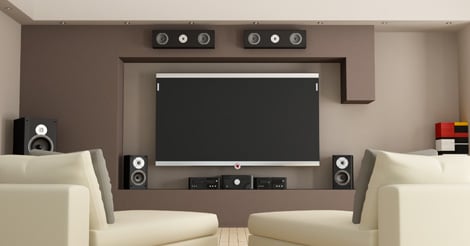Beginner’s Guide to Home Theater
A home theater can be as basic as two or three A/V gadgets in your family room or as mind-boggling as a totally redesigned storm cellar intended to resemble Grauman’s Chinese Theater. At its center, a home theater framework ought to give an astounding video experience and immersive sound that will bring your most loved films to life. This article offers a general outline of the fundamental home theater components and how they work together.
Choose the right display for Your Home Theater
 When you imagine a theater-like video experience, you most likely think first about a projector and a giant movie screen. That is absolutely the display of choice in the model home theater. The two-piece setup is most appropriate for a devoted theater room, in which you can totally control the lighting. Projectors aren’t exclusively for the rich and famous. For the best screen-size-to-price proportion. Sony, JVC, and Optoma offer mid-level projectors which fall in the $2,000 to $10,000 value range, while Epson, Panasonic, and Sanyo offer excellent entry level projectors. Concerning the projection screen, you can pick between fixed-mount, pull-up/pull-down, or mechanized screens, and most screen producers offer a wide assortment of screen materials to suit diverse projectors and situations. You likewise need to consider what screen shape you need: Do you need a standard 16:9 screen that is ideal for High Definition or a 2.35:1 screen that gives you a chance to watch CinemaScope motion pictures without black bars. Another alternative is to use curtains to tailor the screen shape to suit every source.
When you imagine a theater-like video experience, you most likely think first about a projector and a giant movie screen. That is absolutely the display of choice in the model home theater. The two-piece setup is most appropriate for a devoted theater room, in which you can totally control the lighting. Projectors aren’t exclusively for the rich and famous. For the best screen-size-to-price proportion. Sony, JVC, and Optoma offer mid-level projectors which fall in the $2,000 to $10,000 value range, while Epson, Panasonic, and Sanyo offer excellent entry level projectors. Concerning the projection screen, you can pick between fixed-mount, pull-up/pull-down, or mechanized screens, and most screen producers offer a wide assortment of screen materials to suit diverse projectors and situations. You likewise need to consider what screen shape you need: Do you need a standard 16:9 screen that is ideal for High Definition or a 2.35:1 screen that gives you a chance to watch CinemaScope motion pictures without black bars. Another alternative is to use curtains to tailor the screen shape to suit every source.
A dazzling theater does not require a two-piece system. Flat screen TVs are widely used in home entertainment. As the price continues to go down you can now get a much larger screen for your cash. Whether you put top dollar in an 85-inch screen or run with a more unobtrusive 50-inch screen, a flat panel HDTV can create an effective home theater framework, and the advantage is that you can watch it in a wide range of lighting conditions. Previously, most analysts would guide you toward plasma HDTVs to get the best home theater execution. LCD HDTVs were once viewed as bright room displays and have made great advancements in performance. LED HDTVs have taken displays to a new level. With local dimming and 120Hz/240Hz refresh rates, LED televisions have improved on restrictions in black level and motion blurring. Top names in LCD and LED televisions include Samsung, Sony, Toshiba, LG, and Sharp.
Presently, 3D is a hot trend in HDTV technology. Most top manufacturers have no less than one line of 3D-competent models. These TVs require the utilization of unique dynamic shade 3D glasses. 3D HDTVs are typically the top-end models in every company’s line and in this manner cost more than comparable non-3D alternatives. In the event that you put resources into a 3D-capable TV, you will likewise require a 3D-fit Blu-ray player to watch 3D motion pictures.
Bring Movies to Life with Incredible Sound
The component that will take a good theater to new heights is incredible sound. Audio that comes from every direction in your theater with clarity and powerful bass is essential to creating that big movie theater experience in your home setup. Basic surround sound includes 5.1 channel setup. This system includes 5 speakers, one each for the front left, front right, back right, back left and front center positions while the .1 designates a subwoofer that delivers the roaring bass for blasts and other low-end impacts. Some home theater installers suggest a 5.2-channel framework, with a second subwoofer that will provide smoother bass over a broader listening zone. By upgrading to a 7.1-channel setup, which adds two side-channel speakers, you will achieve a more robust surround sound experience.
Speakers come in all shapes and sizes and can be towers, bookshelf, on-wall or in-wall models. Top manufacturers have perfected low-profile speakers that are high on execution – Generally, the recommendation is the smaller the speakers, the more worthwhile it is to add a subwoofer to fill in the low end.
If you’re building a committed theater room, you have more flexibility to pick the precise speakers you need and can place them in the perfect positions to get the best execution. If you need to integrate your theater into a current living or family room, you may not have as many options to position speakers for their optimal performance. Alternately maybe you (or your loved one) simply don’t care for messing the room with speakers. All things considered, in-wall or in-ceiling speakers might be exactly what the home theater fan ordered.
On the off chance that you like the thought of surround sound but can’t figure out how to fit a multichannel speaker structure into your room, the soundbar has turned into a well-known arrangement. A soundbar consolidates numerous speaker channels into a solitary speaker bar that mounts above or underneath your TV. These soundbars use acoustic control to make a feeling of surround envelopment through advanced sound bouncing and dividers. This arrangement by and large doesn’t offer the exact impact and higher-end execution you can get from isolated speakers, however, it’s a decent small room or condo solution. It’s likewise an incredible choice for one who is troubled by the nature of their TV speakers and needs an overhaul in sound quality.
Once you’ve collected all of your home theater components, you’ll likely need to put resources into controlling them…that is unless you appreciate using five unique remotes just to watch a movie. A universal customized remote can make life easier for every user in the house. In the event that you have a simple home theater, you may get by with a simple remote that controls a modest bunch of gadgets and has the ability to customize buttons to your own needs. URC MX-450 and Logitech/Harmony are a few remotes that can be customized to control basic theater setups. More advanced controllers like those from Control 4 can not only be programmed to control your theater equipment but also your lighting, shades, whole-house audio and so much more. This kind of system is sold only through specialized dealers and require trained professionals to program.
For more information give us a call at (260) 824-2488 or visit our website ititech.biz. To help get started you can use the “Project Planner” questionnaire on our website.

